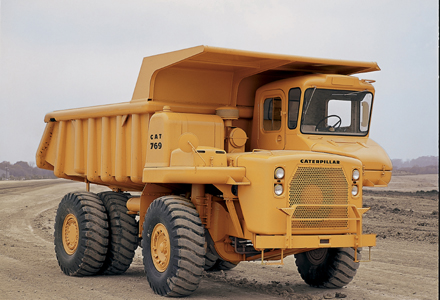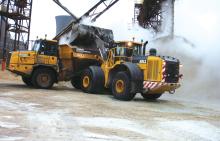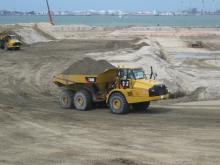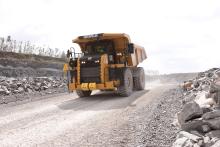
Caterpillar's rigid dump trucks are a well established range but their origins date back 45 years to the 32tonne 769 machine. Mike Woof looks at the company's original concept
When
However, Cat's 769 was an extremely influential and successful machine and was to set the pattern for the company's entire rigid truck range. Cat is now a dominant force in the RDT market and its presence in the sector can be traced right back to the little quarry truck.
The 769 featured a conventional layout with its cab offset to the left of the machine and a rounded appearance to its engine cover that has since come back into design fashion. Power came from a Cat diesel (the company first began producing its own diesels in the early 1930s) and this drove through a conventional gearbox, propeller shaft and differential to the twinned rear wheels. The body was conventional too, with vertical sides and steeply sloping bolster supports.
Cat's entry to the RDT market soon began to establish a reputation as a dependable truck that was durable and tough, and sales began to grow. Even as the popularity of the 769 developed Cat was busy working on new and bigger truck models. Although some trucks with diesel electric drives were developed, these were not a success and were dropped from the range. But the machines using the same layout as the 769, with a conventional mechanical drivetrain, were a huge success and in 1977 came the introduction of the 777, which offered a creditable 77tonne (85 short ton) capacity.
Over the years the 769 was upgraded on a regular basis. It benefited from new developments in engines, body design, cab ergonomics, hydraulics and electronics, as well as a whole host of other technical improvements. The later models were visibly different as the rounded engine cover was replaced with a more square-edged design. In more recent years the near vertical bolsters used to stiffen the body sides were replaced with horizontal stiffeners, while customers were also able to specify a range of body types to suit an application.
In the cab, drivers were also treated to major gains in comfort levels, with more room, better sound attenuation and vastly more comfortable seats. The trucks became easier to drive too, with the installation of automotive-style automatic gear shifting and power steering for instance. Meanwhile Cat had placed safety as a priority, with the old style drum brakes being replaced with discs and effective retardation technology.
The 769 was also joined by a sister machine, the 771, with similar specifications. Advances in diesel technology meant that later versions of the 769 offered considerably more power, while burning less fuel and having lower levels of exhaust and noise emissions. By the time the currently available 769D was launched, its 3408E diesel generated 653kW (net) and allowed a top speed of 77km/h. Its nominal payload was now 36tonnes (40 short tons), reflecting a gradual increase in haulage capacities for small rigid trucks from all of the major manufacturers.
Last year came the news that Caterpillar was introducing the 770 and 772 trucks, which feature C15 and C18 diesels respectively. The new models are only available in some markets and the 769D is still offered in some territories, but it seems that the RDT which started off Caterpillar's entire truck line now looks set to be replaced











